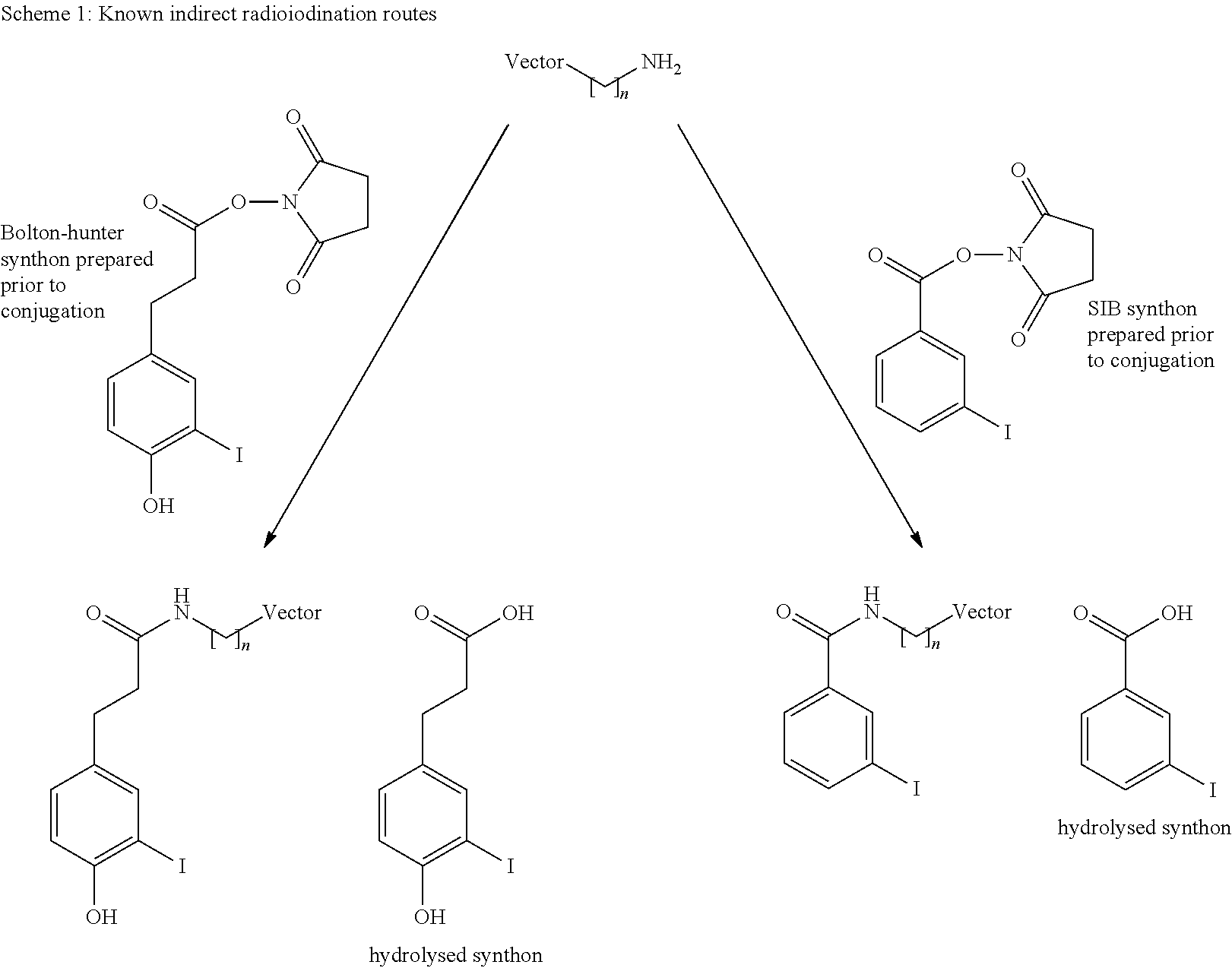Radioiodination method
- Summary
- Abstract
- Description
- Claims
- Application Information
AI Technical Summary
Benefits of technology
Problems solved by technology
Method used
Image
Examples
example 2
Synthesis of 3-iodo-benzoic acid N′-pyridin-2-yl-hydrazide
[0097]
2(i) Reaction Carried Out with 127I
[0098]3-iodo-benzoic acid 2,5-dioxo-pyrrolidin-1-yl ester was prepared by reaction of 3-iodo benzoic acid (1 g, 4 mmol), N-hydroxysuccinimide (464 mg, 4 mmol) and dicyclohexylcarbodiimide (DCC) (4 mls of a 1M solution in dichloromethane, 4 mmol). The reaction mixture was stirred at room temperature for 6 hours in 10 ml DMF The resulting white precipitate was filtered and discarded and the resulting filtrate reduced in vacuo and purified by column chromatography giving a 29% yield.
[0099]127I conjugation of 3-iodo-benzoic acid 2,5-dioxo-pyrrolidin-1-yl ester and 2-hydrazinopyridine was performed in order to purify the product and analyse by mass spectrometry to confirm its identity.
[0100]2-hydrazinopyridine was dissolved in ethanol to give a 9.2 mM solution.
[0101]To a 10 ml sealed silanised glass vial the following were added in the given order:—
20 μl 2-hydrazinopyridine (1.8×10−7 moles)...
example 3
Synthesis of 3-trimethylstannyl-benzoic acid 2,5-dioxo-pryolidin-1-yl ester
3(i) Methyl 3-Iodobenzoate (2)
[0110]
[0111]One drop of dimethylformamide was added to a stirring suspension of 3-iodobenzoic acid (1.0 g, 4.03 mmol), in thionyl chloride (20 ml). The mixture was then heated at 80° C. for 18 hours. After cooling to ambient temperature, the solvent was completely evaporated, then methanol (20 ml) was slowly added and the mixture stirred at ambient temperature for 30 minutes. Evaporation of methanol afforded the crude product as oil which solidified on standing at ambient temperature. The crude product was purified by flash chromatography using ethyl acetate / hexane (1:1) and the pure product was obtained as slightly yellow crystals (824 mg, 78.4%).
[0112]1H NMR (500 MHz, CDCl3, δ 3.95 (s, 3H, CH3), 7.20 (t, 1H), 7.9 (d, 1H), 8.0 (d, 1H), 8.20 (s, 1H)
3(ii) 3-Trimethylstannyl-benzoic acid methyl ester (3)
[0113]
[0114]To a mixture of methyl 3-iodobenzoate 200 mg, 0.76 mmol), and hexam...
example 4
Synthesis of 3-(4-Hydroxy-3-iodo-phenyl)-propionic acid hydrazide
[0123]
[0124]5 mg of Ac-Thr(Mannose-6-Phosphate-Mannose)-Lys-Thr(Mannose-6-Phosphate-Mannose)-NH2 (“glycopeptide”; synthesized according to methods disclosed by Christensen et al J Chem Soc Perkin Trans 1994; 10: 1299-1310) was reacted with 1.7 mg of iodinated Bolton-Hunter NHS ester (“BH”; Wako pure chemical industries 199-09341) and sym-Collidine (1.1 μL, Fluka 27690) were mixed in 1 ml DMF (Rathburn PTS6020) and the mixture (cloudy solution) was heated at 35° C. for 2 h. All BH was consumed and a new peak corresponding to BH-hydrazine conjugate was observed as sole product. More BH (0.5 mg) and sym-Collidine (1.1 μL) were added and stirring at 35° C. was continued for 2 h. Most BH was consumed and the peak corresponding to BH hydrazine had increased. Acetone (100 μL) was added in order to react with remaining residual hydrazine and the mixture stirred over night at room temperature. More BH (2.0 mg) was then added an...
PUM
| Property | Measurement | Unit |
|---|---|---|
| Fraction | aaaaa | aaaaa |
| Fraction | aaaaa | aaaaa |
| Fraction | aaaaa | aaaaa |
Abstract
Description
Claims
Application Information
 Login to View More
Login to View More - R&D
- Intellectual Property
- Life Sciences
- Materials
- Tech Scout
- Unparalleled Data Quality
- Higher Quality Content
- 60% Fewer Hallucinations
Browse by: Latest US Patents, China's latest patents, Technical Efficacy Thesaurus, Application Domain, Technology Topic, Popular Technical Reports.
© 2025 PatSnap. All rights reserved.Legal|Privacy policy|Modern Slavery Act Transparency Statement|Sitemap|About US| Contact US: help@patsnap.com



